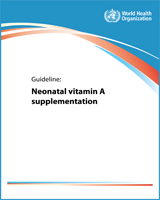Vitamin A deficiency is a major public health problem affecting an estimated 19 million pregnant women and 190 million preschool-age children, mostly from the World Health Organization (WHO) regions of Africa and South-East Asia (1). Infants and young children have increased vitamin A requirements to support rapid growth and to help combat infections. Generally, infants are born with low vitamin A stores (2) and are dependent on external sources, most importantly breast milk, for optimization of their vitamin A levels and body stores. In low- and middle-income countries, infants are likely to receive inadequate amounts of vitamin A from breast milk due to poor maternal nutritional status. However, inadequate vitamin A levels at this age may lead to vitamin A deficiency which, when severe, can cause visual impairment (night blindness), anaemia, weakened resistance to infections, and can also increase the risk of illness and death from common childhood infections such as measles and those causing diarrhoea (3).
In countries where vitamin A deficiency is a public health problem, programmes providing high-dose vitamin A supplements to children 6–59 months of age are being implemented as a child survival strategy. These programmes are reaching 71% of this population in developing countries (4).
There has been considerable interest in vitamin A supplementation in the neonatal period, which was initially proposed as a means to increase the body's vitamin A stores at this age (5), and more recently as a strategy to improve infant survival. However, while three trials, conducted in Indonesia, India and Bangladesh, have shown a reduction in mortality during infancy (5–7), four other trials, conducted in Nepal, Zimbabwe and Guinea-Bissau, did not find any overall reduction in infant mortality (8–11). When the results from the two trials conducted in Guinea-Bissau were pooled, a differential effect was seen by sex, with boys showing reduced mortality and girls showing increased mortality, although a pooled meta-analysis of the other studies did not show this difference (12).
Vitamin A may decrease the risk and/or severity of infections by strengthening the epithelial barrier and by boosting the neonatal immune responses in those at risk of vitamin A deficiency through actions particularly on the development and functions of the various cells of the immune system (13). Vitamin A may also be involved in the development of an appropriate balance of key regulatory immune cells and specific mucosal antibodies in the gut (13); this is essential in the first days of life as the neonatal immune system has to balance its defensive role against pathogenic invasion with tolerance to the developing commensal gut flora. Because of the role of vitamin A in the maturation of organs, including the lung, through the orderly growth and maintenance of epithelial tissues and development of the immune system, neonatal vitamin A supplementation could potentially have an impact on an infant's resistance to infection and diarrhoea, which is the cause of approximately 30% of neonatal deaths (14, 15). Vitamin A supplementation in older infants and children has been shown to have a heterogeneous effect on respiratory infections (16), suggesting that the potential for unanticipated effects mediated via the immune system should also be considered in younger infants.
Administration of vitamin A in recommended doses is not associated with serious or long-term side-effects. However, a single high dose of vitamin A can cause transient acute side-effects in infants, such as bulging fontanelles, vomiting, diarrhoea, loss of appetite and irritability. The most common of these is bulging of the fontanelles, but this is benign and not associated with acute or long-term neurodevelopmental effects (17, 18).

